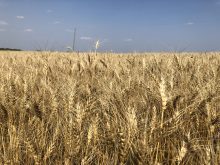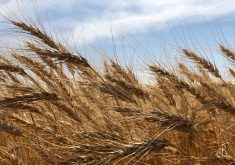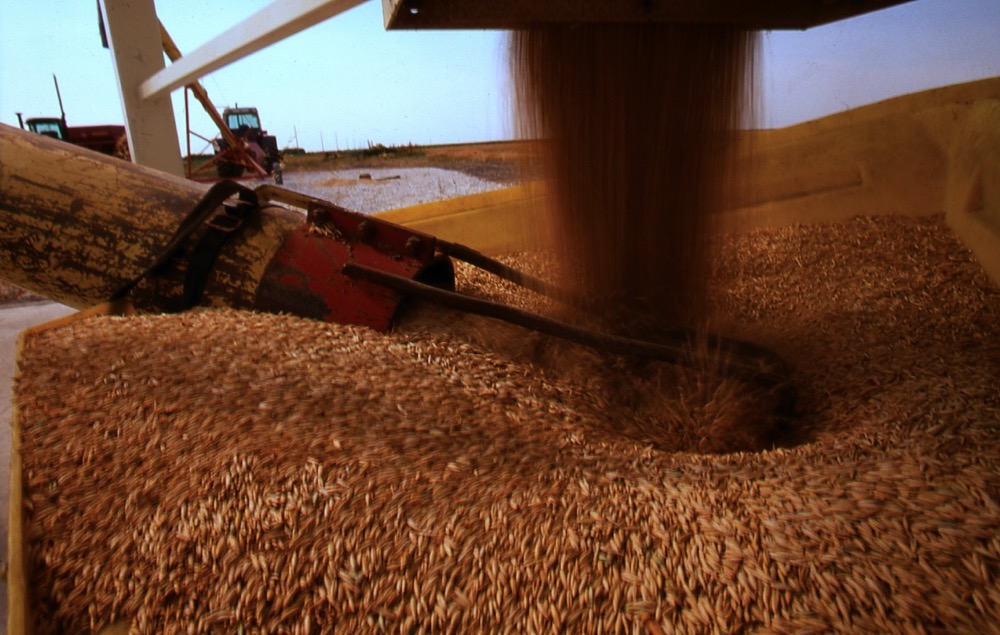It turns out the customer is always right — at least when it comes to Canada’s wheat classification system.
“Concerns from our overseas clients about gluten strength” has prompted a revamp of the wheat classification system, said Mark MacNaughton, director of field crops for Alberta Agriculture and Forestry.
“The Canadian Grain Commission has changed the bar. It has raised the gluten strength (requirement) up.”
On Aug. 1, the commission added a new wheat class — Canada Northern Hard Red (CNHR). American Dark Northern Spring varieties Faller, Prosper, and Elgin ND, currently in the Canada Western Interim Wheat class, will move to the new CNHR class and the interim class will end. These three varieties have slightly lower protein than wheats in Canada’s premiere Canada Western Red Spring (CWRS) class, but are higher yielding.
Read Also

Farming Smarter receives financial boost from Alberta government for potato research
Farming Smarter near Lethbridge got a boost to its research equipment, thanks to the Alberta government’s increase in funding for research associations.
Changes are also coming to the CWRS and Canada Prairie Spring Red (CPSR) class but not until Aug. 1, 2018, when 25 CWRS and four CPSR wheats will move to the CNHR class. Among the CWRS wheats, there are some popular varieties including Harvest and Kane. The grain commission had initially planned to move them in 2017, but delayed it a year to give the industry more time to adjust.
The Canada Western General Purpose (CWGP) and Canada Feed Wheat classes were also eliminated on Aug. 1, with their varieties transferred to the new Canada Western Special Purpose class. Like the CWGP class, the special purpose class does not require end-use quality assessment as a prerequisite to registration.
These changes — particularly the addition of the CNHR class — will improve the quality of Canadian milling wheats for end-use customers, said Trent Whiting, marketing representative at SeCan.

“They’ve made the quality parameters around CPS and CWRS much more difficult to hit, and it’s based on the gluten strength,” Whiting said at the Lacombe Field Day in late July. “They’ve pushed the bar up because end-use customers want that bar higher.”
The Canadian grain industry has been fielding complaints about weaker-than-normal gluten strength for the past several years, in part because popular varieties such as Lillian, Harvest, and Unity have lower gluten strength. And the quality of the final product depends on that gluten strength, he said.
“Class modernization goes back to end-use customers coming to us as an industry and saying, ‘We’re not getting a consistent loaf,’” said Whiting.
“As an end-use customer, you want the same loaf every time. But whether they’ll pay for it — well, I’m not a grain handler, so I can’t say one way or another.”
Marketing changes
Over the next three years, producers will need to pay close attention to which varieties they’re growing, and how those varieties will be classified once the changes come into effect.
“If you’re growing these varieties in 2017, you better be pretty sure when you go to market what classification they’re in, because it might be quite a surprise when you go to market something that you thought was a hard red and it’s now a CNHR,” said MacNaughton.

It’s too soon to say how the new classes will be priced, but “the price differential might be fairly significant,” said MacNaughton.
“If you’re growing Harvest and it works really well for you, it’s going to drop down to CNHR, and you’re probably not going to get paid as much for it,” added Brian Kennedy, grower relations and extension co-ordinator for Alberta Wheat.
“You’re probably going to get paid the lowest common denominator for CNHR. Nobody knows what it will be priced at yet, but it will probably be priced around where CPS is priced at right now.”
For that reason, “paying attention to the market is going to be more important than ever,” said Whiting.
“Every year is going to be a little different. The supply-and-demand curve is really going to play into it,” he said.
If an end-user likes the quality of a variety like Harvest, they “may be willing to pay a premium for it,” as Harvest acres are set to drop.
“They may end up paying a premium for it, but it may be a local premium that you’ll never find anywhere else. We could see a lot of price segregation across the Prairies depending on where your grain-handling catchment is.”
But ultimately, producers will need to choose the right variety for their operation, said Whiting.
“There’s a pile of fabulous varieties out there. The one you grow might be the best one for your farm, so don’t feel that it’s going away,” he said. “It’s a lot of change, but if you like it, keep growing it. It will just be in a new market class.”















